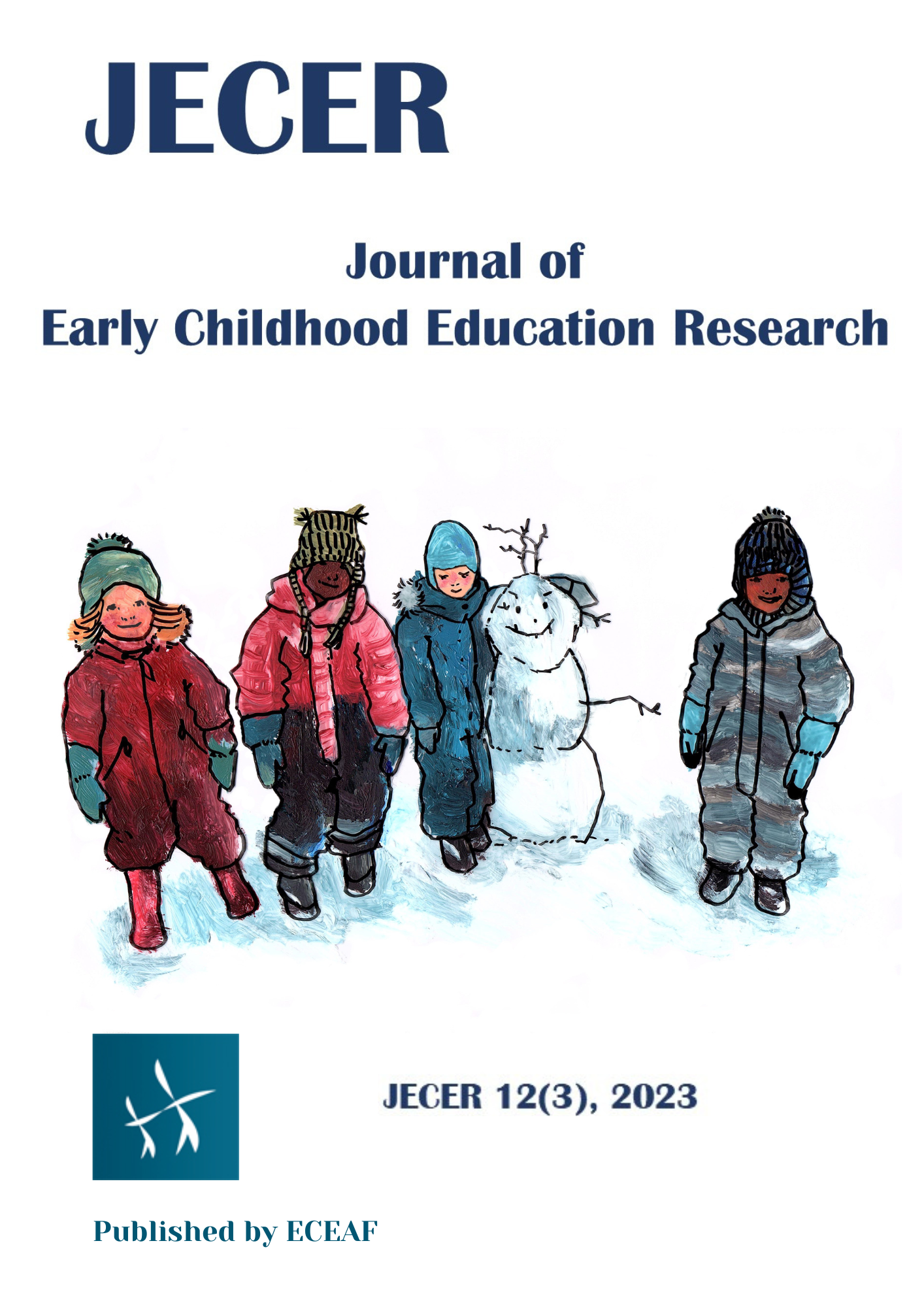Pienten lasten huumorin rakentuminen ”Mua kikattaa kun mä teen jekkuja”
Keywords:
humour, early childhood education, children's perspectives, working cultureAbstract
The study deals with the humor of children under school age in kindergarten. The data consists of video material from five kindergartens and seven groups, observation diaries, children's expressions of humor collected by early childhood education professionals and nursing students, and responses to a questionnaire for educators. Analysis of the video material was implemented as multimodal content analysis, which was supported by examining observation diaries and humor expressions. Further, the analysis of the survey was carried out as a qualitative content analysis. There are special features in the humor of young children that early childhood education personnel should find useful to understand. It is not joking, but humor occurs in everyday games and routines in loose and spontaneous manner. The humor of small children is bodily: sounds, gestures, facial expressions and actions as well as later also verbal humor. Scatological humor, hyper fun and carnivalesque activities are the humor styles of young children. They are not always accepted by adults. The operating culture and atmosphere of early childhood education have an impact on how many opportunities children have to use humor. The conclusion of the study states that young children have versatile humor skills, which adults could even learn from. It would be necessary to present the pedagogical possibilities of humor more than currently, also in early childhood education plans and in-service education of early childhood personnel.
References
Aerila, J.-A., Laes T., & Laes, T. (2017). Clowns and explisions: Drawings as reflections of children’s humor. Journal of Early Childhood Education Research, 6(1), 108–135.
Alatalo, S. & Poutiainen, A. (2016). Use of humor in multicultural classroom. Israeli Journal for Humor Research, 5(1), 65–79.
Bellieni, C. V. (2022). Laughter: A signal of ceased alarm toward a perceived incongruity between life and stiffness. New Ideas in Psychology, 68. https://doi.org/10.1016/j.newideapsych.2022.100977
Bergen, D. (1998). Development of the sense of humor. Teoksessa W. Ruch (Toim.), The sense of humor: Explanations of a personality characteristic (s. 329–358). Mouton de Gruyter.
Bergen, D. (2002). Finding the humor in children`s play. Teoksessa A. J. Roopnarine (Toim.), Conceptual, social-cognitive, and contextual issues in the fields of play (s. 209–220). Ablex Publishing.
Hoicka, E., & Akhtar, N. (2012). Early humour production. British Journal of Developmental Psychology, 30(4), 586–603. https://doi.org/10.1111/j.2044-835X.2011.02075.x
Hoicka, E., & Martin, C. (2016). Two-year-olds distinguish pretending and joking. Child Development, 87(3), 916–928. https://doi.org/10.1111/cdev.12526
Hollo, J. A, (1918). Mielikuvitus ja sen kasvattaminen 1. Wsoy.
Franzini, R. F. (2002). Kids Who Laugh. How to Develop Your Child’s Sense of Humor. SquareOne.
Karlsson, L. (2014). Sadutus. Avain osallisuuden toimintakulttuuriin. PS-kustannus.
Karlsson, L (2020). Studies of child perspectives in methodology and practice with ‘osallisuus’ as a Finnish approach to children’s reciprocal cultural participation. Teoksessa E. Eriksen Ødegaard & J. Spord Borgen (Toim.), Childhood Cultures in Transformation: 30 Years of the UN Convention on the Rights of the Child in Action towards Sustainability (s. 246-273). Brill |Sense. https://doi.org/10.1163/9789004445666_013
Komulainen, S. (2014). Etnografin katse erityispäiväkodissa: Reflektiota aineiston tuottamisesta ja etiikasta. Teoksessa P. Hämeenaho & E. Koskinen-Koivisto (Toim.), Moniulotteinen etnografia (s. 235–307). Ethnos
Loizou, E. (2005). Humour: A different kind of play. European Early Childhood Education Research Journal, 13(2), 97–109. https://doi.org/10.1080/13502930585209701
Loizou, E. (2006). Young children’s explanation of pictorial humor. Early Childhood Education Journal, 33(6), 425– 431. https://doi.org/10.1007/s10643-005-0053-z
Loizou, E. (2007). Humor as a means of regulating one´s social self: two infants with unique humorous personas. Early Childhood development and care, 177(2), 195–205. https://doi.org/10.1080/03004430500387526
Martin, R. A., Puhlik-Doris, P., Larsen, G., Gray, J., & Weir, K. (2003). Individual differences in use of humor and their relation to psychological well-being: Development of the humor styles questionnaire. Journal of Research in Personality 37, 48–75. https://dx.doi.org/10.1016/S0092-6566(02)00534-2
Martin, R. A. (2011). The psychology of humor. Elsevier Academic Press.
Martin, R. A., & Dobbin, J. P. (1988). Sense of humor, hassles, and Immunoglobulin a ‒ Evidence for a stress-moderating effect of humor. International Journal of Psychiatry in Medicine, 18(2), 93–105. https://doi.org/10.2190/724B-3V06-QC5N-6587
McGhee, P. E. (1994). How to develop your sense of humor. Kendall/Hunt Publishing.
McGhee, P. E. (2002). Understanding and Promoting the Development of Children’s Humor. Kendall/Hunt.
Morreall, J. (1982). A new theory of laughter. Philosophical studies, 42(2), 243–254.
Opetushallitus (2022). Varhaiskasvatussuunnitelman perusteet (Määräykset ja ohjeet 2022: 2a). Opetushallitus. https://www.oph.fi/sites/default/files/documents/Varhaiskasvatussuunnitelman_perusteet_2022_1.pdf
Puroila, A-M. (2002). Kohtaamisia päiväkotiarjessa – kehysanalyyttinen näkökulma varhaiskasvatustyöhön [Väitöskirja, Oulun yliopisto]. Acta Universitatis Ouluensis, E 51. http://urn.fi/urn:isbn:9514266501
Puroila, A-M., Hohti, R., & Karlsson, L. (2016). Hassuja juttuja - lasten huumoria päiväkoti- ja kouluympäristössä. teoksessa L. Karlsson, A-M. Puroila, & E. Estola (Toim.), Välkkeitä, valoa ja varjoja: kertomuksia lasten hyvinvoinnista (s. 71–87). N-Y-T NYT.
Reddy, V. (2001). Infant clowns: The interpersonal creation of humor in infancy. Enfance, 53(3), 247–256. https://doi.org/10.3917/enf.533.0247
Stenius, T., Karlsson, L., & Sivenius, A. (2021). Huumori lasten kanssa – ovi yhteisöllisyyteen? Journal of Early Childhood Education Research, 10(2), 239–263. https://journal.fi/jecer/article/view/114165/67364
Stenius, T., Karlsson, L., & Sivenius, A. (2022). Young children’s humour in play and moments of everyday life in ECEC centres. Scandinavian Journal of Educational Research, 66 (3), 396–410. https://doi.org/10.1080/00313831.2020.1869084
Stenius, T., & Aerila, J.-A. (2022). Tuu mun viereen nauraan: Paljon huumoria käyttävien lasten eli hupailijoiden toiminta varhaiskasvatusryhmässä. Sosiaalipedagoginen Aikakauskirja, 23(2), 11–40. https://doi.org/10.30675/sa.124794
Stenius, T., & Karlsson, L. (2023). Huumori kukkii vastavuoroisuudessa. Päiväkodin toimintakulttuuri huumorin mahdollistajana ja rajoittajana. Kulttuurintutkimus, 40(1), 38–54.
Stenius, T. (2023). Lasten huumorin rakentuminen. ”Mua kikattaa, kun mä teen jekkuja” [Väitöskirja. Helsingin yliopisto]. Dissertationes Universitatis Helsingiensis 64/2023. http://urn.fi/URN:ISBN:978-951-51-9467-1
Vuorisalo, M. (2013). Lasten kentät ja pääomat. Osallistuminen ja eriarvoisuuksien rakentuminen päiväkodissa [Väitöskirja. Jyväskylän yliopisto]. Jyväskylä studies in education, psychology and social research 467. http://urn.fi/URN:ISBN:978-951-39-5205-1
Wanzer, M. B., Booth-Butterfield, M., & Booth-Butterfield, S. (1996). Are funny people popular? An examination of humor orientation, loneliness, and social attraction. Communication Quarterly, 44(1), 42–52. https://doi.org/10.1080/01463379609369999

